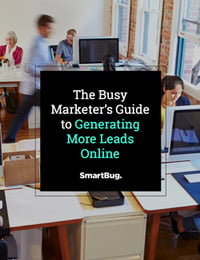
Intent Data: A Direct Line into Prospects Ready to Buy Your Product or Service
September 6, 2019
By Jen Spencer
Imagine sitting down at your desk, opening up your laptop, and discovering a button you'd never seen before on your browser homepage. That button, once clicked, would give you a live feed of people in your target demographic who are actively showing intent to purchase a solution that your product or service provides. Now imagine this was in real time, allowing you to not only connect with these potential new clients but also reach out to them before your competitors even knew they existed.
That, in a nutshell, is “intent data.”
It’s not as simple as a magical button on your browser homepage—but it is a very real set of data analytics based on consumer behavior across the web (not just on your website) that:
- Gives you a front-row seat to live buyer activity, shows you the buyer’s pain points
- Provides a snapshot of the huge digital footprint they leave behind as they consume content across the internet
- Identifies who exactly is and is not ready to purchase your product or service
By the time the average B2B buyer connects with any particular vendor, they’re already more than 70 percent of the way through the Buyer’s Journey—and 67 percent of that journey is digital. So how can you intercept these potential new clients, insert yourself into that journey earlier on, shorten your sales cycle, and get ahead of your competitors?
Statistically speaking, the first (wo)man through the door wins the business 50 percent of the time, and the best way to be first is to use information that your competitors aren’t leveraging. According to Demand Gen Report’s 2018 ABM Benchmark Survey Report, only 25 percent of B2B companies currently use intent data and monitoring tools, with just 35 percent planning to use these tools in the coming year.
Why should you be so concerned with what buyers are doing on websites that aren’t your own? Don’t you already have your own web analytics that allow you to connect and convert buyers when they hit your site? Don’t you already have targeted marketing campaigns to catch buyers searching for your products on Google?
Isn’t that enough?
Think of it this way: Do you want to market your bridal gown to every woman who has ever thought about marriage and looked at a couple of bridal dresses online, or do you want to market your bridal gown to a limited group of women with a digital footprint that indicates they have aggressively increased their research into bridal gowns over the last several weeks?
Hopefully, it’s the latter and you’re at least curious to see how you can incorporate intent data into your workflows and tap into a market that is aggressively searching for your solution online.

Top Five Competitive Advantages of Intent Data
- Shorten the sales cycle and identify which buyers have demonstrated an active interest in your product or service before they reach out to your competitors.
- Easily prioritize leads with lead scoring data, which measures how relevant a product or service is to a buyer’s needs and accurately identifies which buyers are most likely to make a purchase today.
- Customize content marketing and improve current content to address specific subjects and topic areas as well as pain points that the buyer is demonstrating through their research.
- Improve automated actions and better identify a buyer’s position in your sales funnel (e.g., adjusting automated marketing content to address a buyer that has recently moved out of the “just researching” stage and into the “ready to buy” stage).
- Intent data also provides very precise data points that can be used to leverage targeted advertising strategies, such as better long-tail keywords, automated advertising (e.g., specific to a user’s device or a specific word a buyer has used in their research), and optimized e-commerce platforms based on buyer research data across multiple channels and shopping platforms.
The Easiest Way to Get Intent Data
Most marketers are already familiar with and have already used first-party intent data to boost their account-based marketing (ABM) strategies. However, if you’re looking to really get a jump on your competition, the easiest way to get intent data is to purchase it from a third-party vendor that tracks data across millions of websites, social profiles, online communities, and so on.
Which intent data provider is right for you will depend on your specific budget, target market, and the goals you’re trying to achieve. We’ve compiled our list of some of the leading intent data providers in the market today. We would, however, highly recommend connecting with your vendor(s) of choice directly to identify who would best suit your needs
1. Bombora
Bombora collects and aggregates online research activity (specific to the B2B industry) across thousands of websites and media publishers. Using this data, Bombora provides a surge score that lets a company know when a buyer has increased search activity to an above-normal level on a particular topic. This score then helps sales teams focus their time on opportunities that are most likely to end in closed deals and helps marketing teams appropriately segment paid activity.
Bonus: In a partnership with Everstring (a leader in AI-assisted sales and marketing SaaS platforms), Bombora offers additional capabilities that include account targeting for sales and predictive marketing. This partnership allows for the creation of not only an ideal buyer profile but also a snapshot of what that particular buyer is interested in right now.
2. Everstring
Everstring, in a partnership with Bombora, uses firmographic, technographic, and intent data, along with customized global data sets, automation, artificial intelligence, machine learning algorithms, and an organization's own first-party intent data, to help both B2B and B2C companies identify and target potential buyers. The platform allows users to apply predictive modeling to create lists of targeted accounts, break them up by levels of “intent to purchase,” and leverage this information in their sales and marketing campaigns.
Bonus: The Everstring platform can be incorporated into existing CRM systems (i.e., giving sales teams new insights into all accounts, sales data, and reports), to help determine which accounts will generate the most sales.
3. G2
G2 is a unique intent data platform that integrates with HubSpot, Marketo, LinkedIn Sales Navigator, and Terminus to provide real-time analytical insight into not only who is researching your product (or service) on the G2 platform but also who is researching your competitors.
Bonus: G2 is a peer-to-peer review platform with more than 800,000 validated, unbiased user reviews on products and services in the B2B sector.
4. Aberdeen
Aberdeen, which acquired The Big Willow in 2018, provides actionable and highly targeted data designed to improve sales funnels and solutions. Aberdeen provides buyer-intent pages, predictive actions, market intelligence, specific company location, and title and contact information of potential buyers. Aberdeen works directly with data-collecting and buyer intent companies.
Bonus: Unlike traditional intent data providers, Aberdeen provides companies with a series of audits that analyze existing processes, accounts, and media to identify and better inform on existing marketing strategy gaps.
5. TechTarget
TechTarget, using data acquired from the readership of its more than 140 technology-focused websites (plus the integration of first- and third-party intent data), offers data-driven marketing services for B2B technology vendors to identify buyers who are actively searching for IT products and services. The data provided by TechTarget allows for the prioritization of potential buyers, including by buying stage, customer profile matching, and identification of a confirmed project (for which the client’s technology would be needed).
Bonus: Newly released in early 2019, TechTarget’s Priority Engine allows clients to integrate multiple first-party insights to find, track, and convert buyers who are at the “purchasing” stage. Priority Engine also identifies buyer traffic on competitors’ websites.
Intent Data Is Not All Data
Last but not least, it’s important to note that using intent data is not a one-stop solution for finding new clients; it is best used in congruence with other types of data. We’ve already mentioned the use of first-party data, but also keep in mind that other data subsets can include such things as demographics, job level, tech stack, industry, budget, new rounds of funding, and recent mergers and acquisitions. To learn more about how to use data more effectively, click here.
Having the full picture of who your audience is and what they are doing will help you optimize your marketing efforts and sales outreach. For example, intent data would help you avoid expending effort on someone like me, a writer researching intent data; instead, it would help you focus on someone like John Doe, a CMO at a leading Fortune 500 company looking to buy intent data from a third-party vendor.

About the author
Jen Spencer formerly oversaw all operations, executing on SmartBug's growth and market expansion strategy, which is focused on delivering superior, cutting-edge service to the company's customers and partners while continuing to invest in the people and culture that make SmartBug® a great place for employees to work and develop their careers. Read more articles by Jen Spencer.






